Comment prendre un relevé
Thermometer: Keep Clean and Protected
NOTE: This ear thermometer does not require probe covers. Be sure probe tip is clean before and after
each measur
ement.
Earwax or any dirt may stay on the probe tip over time if it's not cleaned or stored properly.
To ensure accurate reading, clean the probe tip with an alcohol swab, wait for 3 to 5 minutes to let the tip
air-dry prior to each measurement.
Never use abrasive cleaning agents, thinners or benzene for cleaning. Take care not to scratch the surface
of the probe lens and the LCD. Use a soft, dry cloth to clean the body of the thermometer. Do not expose
the thermomet
er to extreme temperatures, humidity, direct sunlight or shock. Do not touch probe tip with
fingers.
The
Ear Thermometer includes one 3V lithium battery already installed.
Approximate battery life is three years. If the Low Battery Display appears,
you can take only a few more measurements.
If the thermomet
er does not function at all, the Dead Battery Displa
y
appears (Figure 1). Immediately replace the battery as follows:
1 Unscrew battery cover to remove it, (Figure 1).
2 R
emov
e the old battery by pulling it out and up. Install a new
3V CR2032 lithium battery (Figure 2).Battery will snap into place.
3 Replace the battery cover by screwing securely into place.
Ba
tt
ery R
eplac
ement
CA
UTION: Replace only with 3V CR2032 lithium battery.
Use of other types of batteries may present a risk of fire or rupture.
WARNING:
• Keep battery out of child’s reach. Swallowing battery could be fatal.
•
Battery should not be charged or placed into extreme heat as it may
rupture.
• Used batteries should be disposed of properly.
1
2
Dead Battery Display
Positive (+) Side Up
Ear Thermometer
49501B
H
ow Does it Work?
The Ear Thermometer obtains 12 readings in 1 second by measuring the
i
nfrared heat given off by the eardrum and surrounding tissues and
converts this temperature into an oral equivalent temperature.
T
emperature From The Ear
Clinical research has shown that the ear is an ideal site for taking body
temperature. The eardrum shares the same blood supply with the
hypothalamus, the part of the brain that controls body temperature.
Therefore, the ear is an accurate indicator of internal body (core) temperature.
T
emperature Measurements Range
Many people believe that normal body temperature is 98.6°F (37.0°C).
However, medical research has shown that temperature varies from person
t
o person. Factors affecting body temperature include age, gender, physical
activity, environmental temperature, clothing, medications, and time of day.
O
ral temperatures may range from 96.4°F (35.8°C) to 100.4°F (38.0°C).
K
now Your Unit
Car
e and Cleaning
Termómetro de oído
49501B
C
omment il f
onctionne
Le Thermomètre auriculaire fournit 12 relevés en 1 seconde en mesurant la
température de la chaleur infrarouge dégagée par la membrane du tympan et
les tis
sus en
vir
onnants, et convertit cette température en une température
orale équivalente.
Température de l’oreille
La r
echer
che clinique montr
e que l’oreille est un endroit idéal pour prendre la
température du corps. La membrane du tympan partage la même réserve sanguine
que l’hypothalamus, la partie du cerveau qui contrôle la température du corps.
Donc, l’oreille est un indicateur exact de la température interne du corps (centre).
Plages de relevés de température
Plusieurs personnes cr
oient que la température normale du corps est de 37,0 °C
(98,6 °F). Cependant, des recherches médicales démontrent que la température
varie d’une personne à l’autre. Les facteurs influençant la température du corps
incluent : l’âge
, le se
x
e
, l’
activité ph
y
sique
, la température environnementale, les
vêtements, les médicaments et le moment du jour. Les températures orales peuvent
v
arier de 3
5,8 °C (96,4 °F) à 38,0 °C (100,4 °F).
Connaissance de votre unité
La fonction de mémoire du Thermomètre auriculaire enregistre les 12 derniers relevés. Le
dernier relevé apparaîtra pendant environ deux secondes après avoir mis le thermomètre en
marche et après le test intégré. L’affichage de départ apparaîtra alors après le dernier relevé
indiqué. Cette fonction vous permet de comparer votre plus récent relevé aux précédents. Pour voir les 12 derniers
r
elevés : Mettre l’appareil hors fonction, pressez et tenir le bouton d’activation enfoncé pendant 3 secondes. Relâchez
le bout
on, l’écr
an afficher
a un petit « M » dans le coin. Pressez sur le bouton d’activation, l’appareil défilera jusqu’au
relevé 1. Pressez de nouveau le bouton d’activation, et l’appareil défilera au relevé 2, et ainsi de suite.
Fonction de mémoire
Pour faire passer l’affichage de °F à °C, mettre simplement l’appareil hors fonction, appuyez et tenir le bouton d’activation
enf
oncé jusqu’à c
e que l’
affichage de départ apparaisse. Appuyez et gardez enfoncé le bouton
d’activation pour passer de ºF à ºC, et vice versa. Lorsque vous avez choisi une échelle de
mesure, attendez jusqu’à ce que la DEL du thermomètre présente un affichage complet.
Changer de F
ahr
enheit à Celsius et viceversa
NOTE: Assurez-vous que le bout de la sonde est propre avant d’utiliser le thermomètre.
V
oir la rubrique « Entretien et nettoyage ».
1 Pr
es
se
z et dégage
z le bouton MARCHE. Le
Thermomètr
e auriculair
e
f
er
a un t
es
t
intégré et un écran DEL complet apparaîtra pour 1 seconde. L’affichage rétroéclairé de
la dernière température mesurée apparaîtra pendant 2 secondes. Attendez d’entendre
un bip court et l’affichage de départ apparaîtra, tel qu’indiqué.
2 T
ir
e
z délica
tement l’oreille vers le haut et vers l’arrière pour redresser la courbe naturelle du conduit auditif. Insérez
le thermomètre jusqu’à ce que le bout de la sonde scelle le conduit auditif.
• Pour les enfants de moins de 1 an : tirez l’oreille vers l’arrière.
• Pour les enfants de plus d’un an jusqu’à l’âge adulte : tirez l’oreille vers le haut et vers l’arrière.
3 Pr
es
se
z et t
enir enfoncé le bouton d’activation après avoir mis le thermomètre en place et lorsque vous êtes prêt à
prendre la température. Lorsque vous entendez un long bip, le relevé est terminé et sera affiché en rétroéclairage
pendant 4 secondes. L’icône « C » ou « F » clignote pour indiquer que l’appareil est prêt à prendre un autre relevé.
Appuyez sur le bouton de Marche/Arrêt pour fermer l’appareil.
NOTE ALERTE DE FIÈVRE : Si le patient a une température élevée, le relevé clignotera et 10 bips courts se feront
entendre. Retirez le thermomètre de l’oreille. Lisez le relevé sur l’affichage DEL.
NO
TE:
P
our un r
ele
vé e
x
act, il es
t es
sentiel de bien placer le thermomètre dans le conduit auditif. Si le
Thermomètr
e
auriculaire
n’est pas inséré correctement et fermement dans le conduit auditif, vous pourriez obtenir un relevé plus bas.
Rappelez-vous de toujours utiliser la même oreille. La température entre l’oreille droite et l’oreille gauche peut varier.
Notes Importantes
•
Une t
empér
a
tur
e éle
vée ou pr
olongée e
xige une attention médicale, particulièrement pour les jeunes enfants.
Contactez votre médecin.
•
Pour un nouveau-né, il est préférable que l’enfant repose à plat, tête de côté de manière à ce que l’oreille soit vers le
haut. P
our un enfant plus âgé ou un adulte, il est préférable d’être debout derrière la personne. Il est préférable de
pr
endr
e tr
ois r
elevés dans la même oreille et d’utiliser le plus élevé.
•
N’
oubliez pas que le thermomètre se fermera automatiquement après une minute.
•
Si vous avez des questions au sujet de tout relevé obtenu, vérifiez pour vous assurer que le conduit auditif est libre
de toute quantité excessive de cérumen et que bout de la sonde est propre (voir « Entretien et nettoyage »).
•
Pour assurer un relevé exact, changez d’enveloppe de sonde après chaque relevé. Rangez ensuite le thermomètre
dans un endroit sec et à température ambiante.
A
f
fichage A
f
fichage
complet de départ
NOTE: Date code is
located on package.
Probe Tip
L
CD Display
with illumination
On/Off
B
utton with
A
uto Shut-Off
Activation
Button
B
out de la sonde
Affichage DEL
B
outon
M
ARCHE/ARRÊT
avec arrêt automatique
B
outon d’activation
NO
TE:
le c
ode de da
te
situé à l’arrière de
l
’emballage.
M
anufactured By / Fabriqué par / Fabricado por: ©2007 Dorel Juvenile Group. All Rights Reserved.
www.djgusa.com (800) 544-1108 www.safety1st.com Made in CHINA. Fabriqué CHINE. Hecho en CHINA.
Styles and colors may vary. Les styles et les couleurs peuvent varier. Los estilos y los colores pueden variar.
D
istributed by (distribué par) (distribuido por) Dorel Juvenile Group, Inc., 2525 State St., Columbus, IN 47201-7494
Dorel Distribution Canada, 873 Hodge, St. Laurent, QC H4N 2B1
11/29/07 4358-3952A
N
OTE:
B
e sure probe tip is clean before using. See Care and Cleaning.
1 P
ress and release the “On/Off” button. The
E
ar Thermometer
w
ill run a
b
uilt-in test and a full LCD screen will display for 1 second. The last
t
e
mperature measured appears with backlight for 2 seconds. Wait until you
hear a short beep and the ready display appears, as shown.
2 G
ently pull ear up and back to straighten the ear canal. Insert the
thermometer until the probe tip seals the ear canal.
•
Fo
r children under 1 year:
P
u
ll the ear straight back.
•
Children ages 1 year to adult:
P
ull the ear up and back.
3 P
ress and hold the Activation Button once you have the thermometer in place and are ready to take a
r
eading. When you hear one long beep the measurement is complete and will display with backlight for
4 sec
o
nds. The “C” or “F” icon flashes to indicate that the unit is ready to take another measurement.
P
ress the On/Off button to power off.
F
EVER ALERT NOTE:
I
f patient has an elevated temperature,
r
eading will blink and 10 short beeps will sound. Remove the thermometer from the ear. Read the
m
easure
ment on the LCD display.
N
OTE:
P
roper placement within the ear canal is essential for accurate reading. If the
E
ar Thermometer
i
s
n
ot inserted properly and firmly into the ear canal, a lower reading might be obtained. Remember to
always use the same ear. The temperature between the right and the left ear may differ.
Important Notes
•
High or prolonged fever requires medical attention, especially for young children. Contact your physician.
•
F
or an infant, it is best to have the child laying flat with his head sideways so the ear is facing upwards.
F
o
r an older child or adult, it is best
to stand behind and slightly to the side of the child. It is recommended
t
hat
thre
e te
mpera
tur
es in the same ear be taken and the highest one used as the reading.
•
Keep in mind that the thermometer will automatically shut-off after one minute.
•
If you question any of the readings you get, check to see that the ear canal is free of excessive amounts
o
f earwa
x and that the probe tip is clean (see Care and Cleaning).
•
T
o ensure an accurate measurement, clean probe tip after each measurement. Store the thermometer in
a dry place at room temperature.
The Ear Thermometer memory function stores the last 12 measurements. The last measurement will
appear for approximately two seconds after turning the thermometer on and after it runs its built-in test.
The ready display will then show after last reading appears. This feature allows you
to compare your most recent measurement to the prior ones. To scroll through the
last 12 measurements: With unit off, press and hold the activation button for 3 seconds.
Release button, screen will display small “M” in the corner. Press activation button, unit will scroll to
reading number 1. Press activation button again, will scroll up to reading number 2, and so on.
How to Take a Measurement
Memory Function
T
o s
witch the display between °F and °C, simply turn OFF the unit, press
and hold the Activation Button until the “°F” turns on. Press and release
the A
ctiva
tion Button to switch from ˚F to ˚C, and vice-versa. Once you
have selected a measurement scale wait until the thermometer LCD
sho
w
s a full display.
Changing fr
om F
ahr
enheit t
o C
elsius and vic
e-versa
The Fever Alert occurs during temperature measurement when the temperature is over 99.4°F (37.5°C). If
pa
t
ient has an elev
a
t
e
d temperature, reading will blink 5 times and 10 short beeps will sound.
H
igh or pr
o
longed f
eve
r r
e
quir
e
s medical a
t
t
e
ntion, especially f
o
r y
o
ung childr
e
n.
Co
ntact y
o
ur ph
ys
ician.
Fever Alert
F
ull Display Ready Display
Display Meaning Action
L
ow
Temperature
D
isplay
H
igh Ambient
Temperature
D
isplay
L
ow Ambient
Temperature
D
isplay
E
rror Function
Display
Low Battery
D
isplay
No display or
f
ixed display.
Reading blinks 5
times and 10
short beeps
o
ccur.
M
easured temperature too
low, 3 short beeps are
e
mitted.
A
mbient temperature too high
(above 104.0˚F or 40.0˚C). 3
s
hort beeps are emitted.
A
mbient temperature too low
(below 50.0˚F or 10.0˚C). 3
s
hort beeps are emitted.
T
hermometer has
malfunctioned. 3 short beeps
are emitted.
Battery voltage is low.
T
emperature measurement is
still allowed.
The thermometer should be
r
eset or the battery should be
replaced.
FEVER ALERT: Patient has an
e
levated temperature.
P
robe may have been inserted
incorrectly. Retake temperature
m
easurement.
T
ake the measurement in operating
temperature range.
(
50.0˚F-104.0˚F/ 10.0˚C - 40.0˚C)
T
ake the measurement in operating
temperature range.
(
50.0˚F-104.0˚F/ 10.0˚C - 40.0˚C)
T
urn the thermometer off and re-
take temperature measurement.
Replace old battery with new
b
attery after taking the
measurement.
Replace the battery or reset the
t
hermometer by turning the
thermometer off and on again.
Consult with a physician for
t
reatment.
Troubleshooting
Temperature measurement range: 89.6°F – 108.0°F (32.0°C – 42.2°C)
Operating temperature range: 50.0˚F - 104.0˚F (10.0˚C - 40.0˚C)
Ear Thermometer meets accuracy requirements established in ASTM Standards E1965-98.
B
atteries:
o
ne 3V lithium battery, CR 2032.
A
clinical summary is available upon request. For home use
o
nly.
S
torage temperature range:
-
4.0˚F - 122.0˚F (-20˚C - 50˚C)
A
STM laboratory accuracy requirements in the display
range of 98.6°F to 102.2°F (36°C to 39°C) for infrared
t
hermometers is ±0.4°F (±0.2°C), whereas for mercury-in-
g
lass and electronic thermometers, the requirement per
A
STM Standards E667-86 and E1112-86 is ±0.2°F (±0.1°C).
T
e
chnical Specifications
Maximum Laboratory Error
T
emperature Maximum Error
F
ahrenheit Scale:
9
6.8˚F to 102.2°F ±0.4°F
Outside this range ±0.5°F
Celsius Scale:
3
6˚C to 39°C ±0.2°C
O
utside this range ±0.3°C
Dorel Juvenile Group, Inc. warrants to the original purchaser that
this product (Ear Thermometer), is free from material and
workmanship defects when used under normal conditions for a
period of one (1) y
ear from the date of purchase. Should the
product contain defects in material or workmanship Dorel
Juvenile Group, Inc., will repair or replace the product, at our
option, fr
ee of charge. Purchaser will be responsible for all costs
associated with packaging and shipping the product to Dorel
Juvenile Group Consumer Relations Department at the address
not
ed on the front page and all other freight or insurance costs
associated with the return. Dorel Juvenile Group will bear the
c
ost of shipping the repaired or replaced product to the
purchaser. Product should be returned in its original package
ac
companied by a proof of purchase, either a sales receipt or
L
imited One-Year Warranty
other proof that the product is within the warranty period.
This warranty is void if the owner repairs or modifies the
product or the product has been damaged as a result of
misuse. This warranty excludes any liability other than that
expressly stated previously, including but not limited to, any
incidental or inconsequential damages.
SOME S
TATES DO NOT ALLOW THE EXCLUSION OR
LIMITATION OF INCIDENTAL OR CONSEQUENTIAL
DAMAGES, SO THE ABOVE LIMITATION OR EXCLUSION
MA
Y NOT APPLY TO YOU.
THIS W
ARRANTY GIVES YOU SPECIFIC LEGAL RIGHTS, AND
YOU MAY ALSO HAVE OTHER RIGHTS THAT MAY VARY
F
ROM STATE TO STATE OR PROVINCE TO PROVINCE.
Une alerte de fièvre se produit pendant la lecture de la température lorsque celle-ci excède 37.5°C (99.4°F).
Si la température du patient est élevée, la lecture clignotera 5 fois et 10 bips courts se feront entendre.
Une t
empérature élevée ou prolongée exige une attention médicale,
particulièrement pour les jeunes enfants. Contactez votre médecin.
Alert
e de fièvr
e
WARNING:
• NEVER allow a child to play with this thermometer. It is not a toy. It is a sensitive electronic device
and may be damaged if not used properly under parental supervision.
•
ALWAYS supervise your child when using thermometer.
MISES EN GARDE :
• NE JAMAIS laisser un enfant jouer avec un thermomètre. Ce n’est pas un jouet, mais plutôt un
dispositif électronique sensible qui peut être endommagé s’il n’est pas utilisé sans la
sur
veillance rapprochée des parents.
• Surveillez
TOUJOURS votre enfant lors de l’utilisation du thermomètre

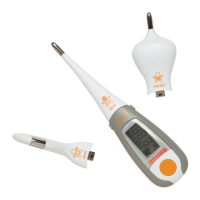
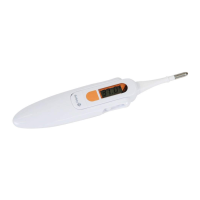
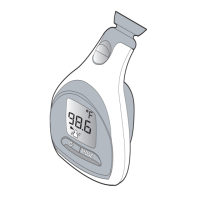
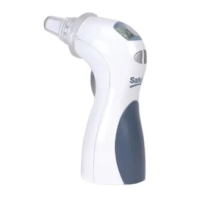


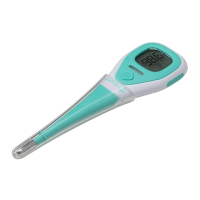
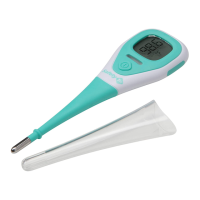

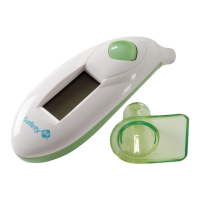
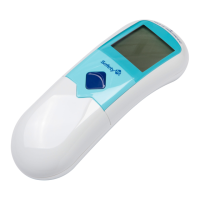
